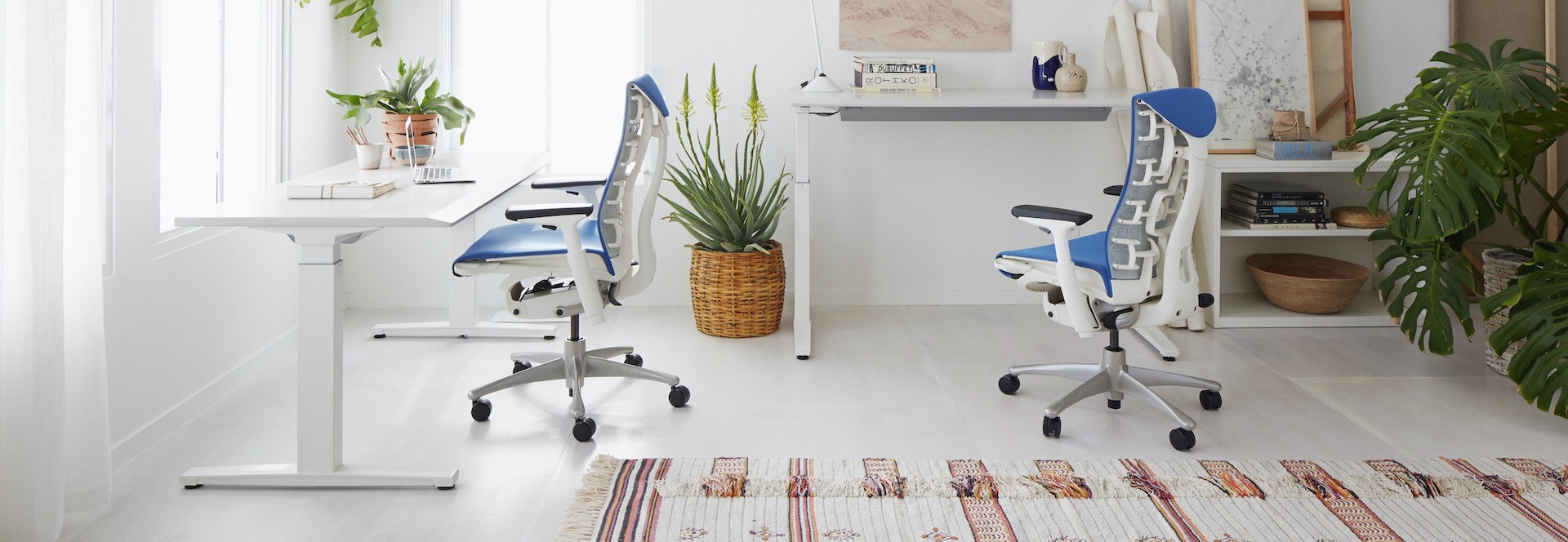Cognitive Ergonomics During a Quarantine – Part 1
By Charles Baxter, Insight Programme Manager, Herman Miller

During this period of self-imposed (or governmental) quarantine many see this as a logistical nightmare and others are having their flexible work dreams realised. Many, I imagine, may also be sat at home thinking “careful what you wish for.” Meme such as “I use to sneak out of my house to go to parties and now I sneak out of parties to go home” are being replaced with “when you try to work from home” meme featuring Professor Robert Kelly when he was being interviewed live on BBC.
Working from home (WFH) will present for many an array of challenges that you will be either consciously or unconsciously aware of. This article is a two-part series and addresses a number of ergonomic issues that you may want to be taken into consideration now that you’re working from home.
Ergonomics or Human Factors is the study of interactions among humans and other elements of a system with the intent to optimise human wellbeing and overall system performance. (International Ergonomics Association).
To help us understand the human system we can break ergonomics down into 3 parts:
– Physical
– Cognitive
– And Social
The way these elements work together creates an ‘ergonomic system.’
This article will focus on cognitive ergonomics which is about understanding why people do the things they do when performing tasks, and it also helps them do those tasks more easily and efficiently.
Cognitive ergonomics is about the brain, or the way people process information. The purpose of cognitive ergonomics is to optimize the fit between human cognition and a particular environment, like the office or in this instance working from home. Cognitive ergonomics affects the way we think and react to our environment and those around us.
Let’s drill down into three principles of cognitive ergonomics, the impact that WFH can have, and some potential solutions to ease your working day.
Mental load – we’re only human – 30-50% disruption with WFH
We can only process a finite amount of information at any one time. When we exceed that limit, we make more mistakes and feel stress. Furthermore, there are different ways we can feel overloaded. Clutter, noise, too many tasks due at the same time, a demanding manager are just a few of the things that contribute to mental load.
Obviously, those working from home don’t have access to the same resources that they once had in the office and are making do in their current circumstances.
Getting to grips with new technology like Microsoft Teams, WebEx or Google Hangouts (to name but a few) will increase cognitive load and frustration so please be patient with yourselves and your colleagues as they adapt to this new less resourceful routine. It will come after a couple uses and will add to your skillset in no time.
We can help reduce a person’s mental load while WFH. Some have to do with design; others are related to management practices:
- Reduce clutter. Getting rid of clutter cuts down on the number of cues that need to be sorted. Digital clutter also affects mental load, so you can reduce your mental load by doing digital housekeeping regularly, such as clearing your cache or organizing your desktop. Also, there is a difference between clutter and personalization. Having a few photos or mementos around you actually decreases stress.
- Reduce or manage noise. Noise is another cue that a person has to sort through. It’s also a distraction because it divides your attention or causes a shift in where your attention is placed. Be sure you are working in a designated space that allows you to focus on the task at hand.
- Task specific products and software. Specify products with intuitive controls and that provide accurate and complete cues that direct people’s attention to the right place at the right time.
- Create multiple working zones for different degrees of mental load. Quickly responding to a short email can be done with higher degrees of stimulation compared to writing a report which might require less distraction and interruptions by the other members of the household. One way to handle this is to designate time in your day for specific tasks such as emails, conference calls, research, etc., depending on the mental load they require.
- Regular brain breaks. People WFH often work through their lunch hour but I would advise that you keep the same period of cognitive down time in your WFH schedule as you did in your office based one. What has been quite successful in my team is digital coffee breaks both within and outside of working hours.
Cognitive Mapping – 30-50% disruption with WFH
Design can offer cues that help people make sense of their environment. Scale, contrast, and wayfinding are all things a designer can use to help people understand and move through an environment easily and naturally. Research shows that we feel before we think, and design can help people intuit what the space is for.
Fortunately, there are very few places you know better than your own home. The only difference is that if this is your first time WFH you will be exhibiting very different behaviours during office hours in your own space. Previously where the sofa was a source of comfort and self-soothing it has now become a source of back pain and distraction.
You will now have to look at your home environment through a different lens and strategically plan out your activities in different spaces around your house. You know the territory, but now you must create the work map or be governed by your reactive unconscious needs.
The smart solution for corporate and home offices, Herman Miller furniture pieces can be purchased from All Office, the sole stockist of Herman Miller furniture in Africa.
Visit www.alloffice.co.za for more information.






